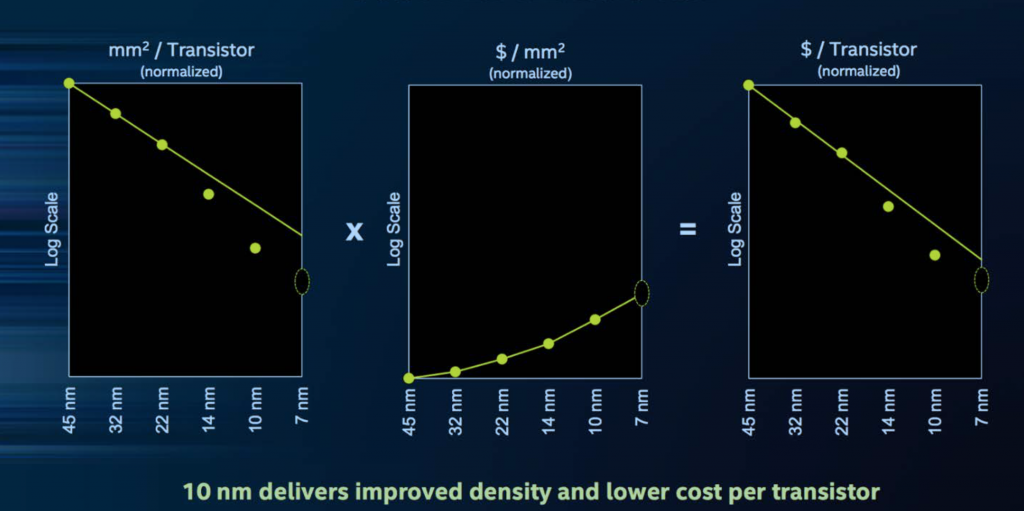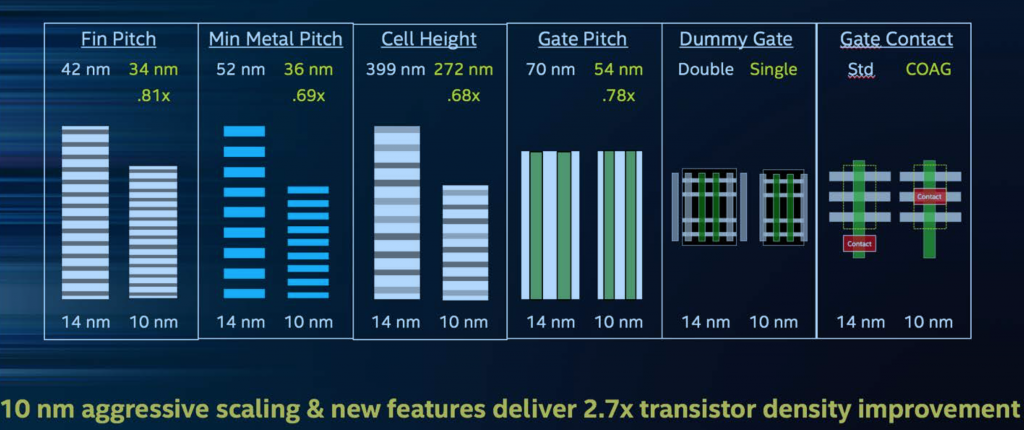Earlier this week, Intel held its own ‘tech day' during which it went over various technologies it is currently working on. One of the major points of the presentation was the upcoming 10nm process node, which Intel claims is a ‘full generation ahead' of the 10nm technology competing chip makers are using, including Samsung, TSMC, Qualcomm and others.
So what is so different about Intel's 10nm tech compared to its rivals? Well for starters, it uses third-generation FinFET technology, but there is a bit more to it than that. One of the key focusses for Intel when it comes to 10nm is Hyper Scaling, which allows Intel to “continue the benefits of Moore’s Law economics by delivering transistors that are smaller and have lower cost-per-transistor”. We can see Intel's example of this in the graph below, which was published as part of the press materials for this event.
With Intel's 10nm node, the company claims it can deliver a 2.7x improvement in transistor density compared with its 14nm products. This is achieved due to the ‘minimum gate pitch' shrinking from 70nm down to 54nm and the minimum metal pitch coming down from 52nm to 36nm. This enables a logic transistor density of 100.8 mega transistors per mm squared, which is estimated to be double that of competing 10nm chips.
Aside from that, Intel's jump from 14nm to 10nm will bring further improvements. The latest process node is said to deliver up to 25 percent better performance at a 45 percent lower power draw. An upcoming enhanced version of the 10nm process known as '10++' will boost this performance benefit by an additional 15 percent, while reducing power draw by a further 30 percent.
KitGuru Says: While other companies might already be out of the gate with 10nm products, it sounds like Intel's own node is much more refined. If Intel's 10nm CPUs can really deliver those performance advantages, coupled with reduced power draw, then this could end up being a big generational leap.
 KitGuru KitGuru.net – Tech News | Hardware News | Hardware Reviews | IOS | Mobile | Gaming | Graphics Cards
KitGuru KitGuru.net – Tech News | Hardware News | Hardware Reviews | IOS | Mobile | Gaming | Graphics Cards





Guys, april fools is only tomorrow, and no one is falling for the 40% performance increase joke anymore, anyway. It stopped being funny long ago 😛
its easy though, they release the CPU they’ve kept in storage for years since AMD has been garbage until recently. plus, they add the secret sauce, half way decent thermal paste under the lid.
Remember, coffee lake (end of this year or some such) is still 14nm, so this 10nm is not something we’ll see for at least another year if not more. If they want to stop AMD from taking back market share, they better bring the secret sauce and all that jazz with coffee lake, not in another 12-16 months, by then the damage is done.
its actually today if you live near the dateline
Blowing smoke 😛
hey intel fanboys, do you see now why we need a strong amd around? if ryzen was another fail the next intel would be like 2% stronger…
Yeah didn’t we hear this same story when we went from 22nm to 14nm? We’d see SO MUCH performance-per-watt increase, we’d be dazed for days. Now, 3(!!) iterations into 14nm, the 7700k performs 12% better than the 4790k, 5% of which is pure clockspeed increase, at a 3.5% higher powerdraw (91w vs 88w). And price remained the same too. So, they’re using less silicone and barely improved performance, and thus we can conclude : all savings made from moving from 22nm to 14nm went straight into intel’s pockets. But sure, THIS TIME it’ll be different. *le sigh*
Wrong. Intel confirmed Cannon and Coffee launch together (because 10 will give higher benefits to mobile processors up front along with E5/E7 Xeons, but the upper ceiling on clock speed will take a hit out of the gate, so for desktops it won’t be nearly as useful), and 8 months lead time from announcement of bulk production to being on the shelves is Intel’s usual M.O.
We did see that performance/watt increase, or do you not bother keeping up with things like Linpack? It’s not Intel’s fault the games industry won’t start optimising for AVX despite the fact it’s in the PS4 (Jaguar), Bulldozer, Sandy Bridge, and all later processors.
You do understand that making cpus have 5+ year plans right? The only thing the competitor could have changed about Intel in so little time is the way they are marketing it and how they endup positioned on the marketed once released.
Its like Intels new 7nm factory in the US, it will take years for us to see products from that one, do you really think that any AMD cpu a few years from now will change anything about their 7nm production? People are delusional.
I know, we knew for ryzen what was about to deliver for years now, intel could be idiots to not be ready to react if amd really hit the 40% target. if amd had failed again they could keep the plans for a later date or just in case.
There would be no need for them to rush.